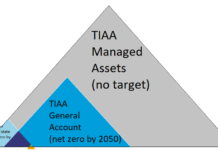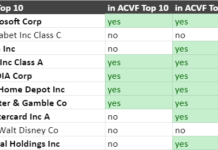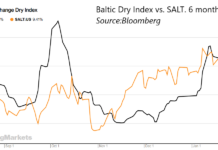It’s that time of year again. I’ve started studying for the third (and final) CFA® exam, and my readers are "treated" to my theories of the market and trading. No stock picks today; put your thinking caps on!
CAPM: Nice Theory, Too Bad About the Market
In Level II of the exam, we studied efficient-market theories, such as CAPM and APT. I actually like an elegant theory (I spent nearly decade of my life studying mathematics), but as a market practitioner, I know the market doesn’t work that way. I learned this lesson the hard way.
Early in my investing career, I would short overpriced stocks. For instance, I twice shorted Amazon (NASD:AMZN) in 1999. At the time, Amazon was bouncing up and down between $50 and $100 (split adjusted), and, looking back 8 years later, it was clearly overpriced even at $50. After all, it’s only at $88 today, meaning the annualized return from buying the stock in 1999 at $50 has been about 7%, while the expected return under CAPM for a stock with a Beta of 3.02 would be around 18% per annum. (Assuming a 6% risk-free rate equal to the ten year Treasury note yield at the time, and a very low equity risk premium of 4%.)
Put another way, if Amazon had been fairly valued according to CAPM at $50 in 1999, it should have been around $190 in 2007, when in fact it mostly traded below $100. It should never have fallen below $6 in 2001.
Looking back at my records, I actually made money on those two shorts (I made $4,661 on the first and lost $3,045 on the second), but it’s the loss that stuck in my mind and prompted me to use this example. After I closed out the first short near $50, the stock rebounded to $59 and I shorted again. It kept on rising, and I got cold feet and took my loss at $65 (I also needed a tax loss, but that didn’t make it hurt any less.)
Although I didn’t know it when I sold, if I’d tried to wait for the stock to start falling again, as it did in 2000, I would have had to ride through a paper loss of $24,000 before the stock fell to where I was in the black again. Even people who have the margin balance to ride through a reversal like that find it very hard to do emotionally.
Lessons Learned
The lesson I took away from that (and a couple of other painful shorting episodes), is that CAPM alone is a lousy theoretical basis for investing or trading. I still do occasionally short, as I am currently doing with First Solar (Nasdaq:FSLR), but I generally take smaller positions and do not rely solely on valuation.
My primary investment framework is Behavioral Finance, actually a grab-bag of theories which focus on investor psychology to explain market behavior that cannot be explained by traditional theories such as CAPM which assume market efficiency. To my pleasure, Level III of the CFA® exam contains considerable material on Behavioral Finance, which I am reading now.
The Winner-Loser Effect
One of the most widely documented market behaviors which cannot be explained in an efficient market is the Winner-Loser effect. Put simply, stocks which have performed badly over a period of a few years tend to outperform stocks which have performed well over the same period in subsequent periods. I take this to mean that, all else being equal, I should prefer to buy stocks which have performed badly over the last couple years to stocks which have recently done well.
This is harder than it sounds. I think the easiest way to demonstrate this is through introspection. Compare this chart, 
from my original article about Electro Energy (NASD: EEEI) to this more recent chart of the same company:
Looking at the charts, which of these stocks would be easier to buy? If you can honestly tell yourself that the first would be easier to buy, you’re very unusual. I personally would have a much easier time getting myself to buy the second chart, and was only buying the first chart and the dip that followed because I know that I have face my fear to make good trades.
People who bought EEEI at $0.50 when I first recommended it (and managed to hold not sell when the stock dropped as low as $0.30) are now sitting on a 70% gain in just a few months, and can look forward to participating in the same gains that someone who bought it in response to my Top Ten Picks for 2008 article. (I’m almost certain that the reason the stock jumped 40% on December 31st was because of that article… there was no other news relating to the stock that day, and most of the move was due to a single large purchase a few minutes before the close. If you were that buyer, I strongly suggest using limit orders when trading a thinly traded stock like EEEI.)
Cash-Covered Puts
With small cap stocks like Electro-Energy, the only way I have to make sure I buy them when they’re down is keeping a tight rein on my emotions, but with larger capitalization stocks which have exchange-traded options available, I have a trick that makes it much easier. Consider another pick from the same article, FuelCell Energy (NASD:FCEL.) Part of the reason I chose to include it in the list is that its five year performance has been lackluster, especially when compared with other alternative energy stocks. Unlike EEEI, I had not been following it closely and only had a small position before I wrote the article. However, I convinced myself that the company has excellent prospects while doing my research, and so I wanted to buy more.
Rather than putting in an order for the stock, I looked at the longest dated options available, in this case options expiring in July 2008. 
I sold (or "wrote") a number of July 2008 $5 FCEL Puts for $0.25 each when the stock’s price fell on January 2nd. For each contract, I was paid $25 by the purchaser, and I
am obligated to buy 100 shares of FCEL at any time between now and July 19th for $500, or $5 each. Keeping the necessary cash available until then, I not only earn interest on the $475 of my money, but also the $25 I’ve already been paid. If FCEL does not fall below $5, that put will never be exercised, and my $475 has earned me about $36 in six months, or a 15% annualized return (actually a little less because I had to pay a commission, but it’s still over 12%.)
If the stock price has fallen to $4 (a situation I find emotionally hard to believe now, but one which I intellectually know is a real possibility) then the put will be exercised, and I will have bought FCEL for about $4.75 a share, even though it’s trading around $10 now. The irony is that, although I’d be jumping for joy at the prospect of buying FCEL for $4.75 a share today, experience tells me that if the option is exercised next July, I won’t feel happy about it at the time.
Here’s what might happen: some bad news will come out about the stock in the next four months, and the stock will fall to $4. I’ll then be sitting on a 16% loss on my $4.75 per share investment in a "loser" stock. If all that happens, and someone asks me if I want to buy more at $4 (16% less than I feel would be the deal of the century if I could have it today), I’d almost certainly say no. In other words, when I wrote those Puts on January second, I tricked my future self into buying a loser.
Losers, in the long term, tend to out-perform winners, and this is a loser I like for all the reasons I outlined, even if I may not be feeling so happy about it in July. In order to get in that position, all I have to do is to not sell the stock for a loss. Not selling a loser you already own is actually easier emotionally than selling and taking the loss.
That’s what I mean by "tricking myself."
Getting Started Writing Cash-Covered Puts
If you’d like to try the above strategy yourself, I have some bad news. While selling cash-covered puts and covered calls are actually lower risk strategies than buying and selling equivalent amounts of the underlying stocks, there are a lot of other things you can do with options that are much, much riskier. For instance, you could sell the puts above, but decide you have better uses for the $500 cash than leaving it in a money-market fund… until the stock falls precipitously and you have to come up with the cash.
Regulators know about these risks, and they make investors jump though a lot of hoops to get option trading permission. The procedure varies from broker to broker, but there is usually a net worth requirement (as if money made people smarter) and you also have to claim that you understand the risks involved. Don’t take short-cuts on this; just reading this article is not enough! Get yourself a good book on options trading , or spend a few days learning about them online (you may have to do some searching… I had trouble finding a free option information resource that I would recommend. But I can tell you what to avoid: anything that talks about getting rich quick

Check with your broker to see if your net worth qualifies you to trade options. Study up on them if you need to, and then fill out your broker’s options trading permission.
My own broker was a day trader in the late 90’s. Like most day traders, he lost his money and had to go back to a real job. He says that the only traders he knew who made money were the ones who wrote puts on stocks they liked.
DISCLOSURE: Tom Konrad and/or his clients have long positions in EEEI, FCEL, and a short position in FSLR.
DISCLAIMER: The information and trades provided here and in the commetns are for informational purposes only and are not a solicitation to buy or sell any of these securities. Investing involves substantial risk and you should evaluate your own risk levels before you make any investment. Past results are not an indication of future performance. Please take the time to read the full disclaimer here.










It seems your logic here might be a bit off.
1) There is no evidence for this winner/looser effect. The concept here which I strongly disagree with is that a stock that has fallen will come back. There are many stocks that fall and go bankrupt or take many years to recover, if they recover at all. And when do you know they’ve fallen enough? 1yr? 2yrs? 3…?
2) Your option example has me confused. If you received .25 for these deeply out of the money $5.00 puts and you buy the puts back or the puts get exercised at $4.00, you’re buying the stock at $4.25, not $4.75. You’ve now covered your puts and your position is now 0, you own nothing.
You’ve now lost .75 or about 16%.
If you’re going to sell deep out of the money options the questions are rather simple. You’re simply making a bet that the price of the stock will not reach this level. Instead of selling at $4.00, why not sell at $5.00? You believed when you sold the option that the price would not reach this level. You were wrong, so get out.
Make your plan before you get in. Have your win point and your loss point predetermined to help take the emotions out of trading.
1. Not all stocks that fall will come back… nor do all stock that rise keep on rising. You don’t know when they’ve fallen enough, but the cash covered
put technique gives you a reward (the premium on the put) for guessing too low.
2) The exercise price of the puts is $5. When they are exercised, you have to stump up $5, but you were paid $.25 initially, so the net cost to you is $4.75. At that point you hold the stock and wait… you don’t sell at all.
Your strategy of planning before you get in does work, and it’s one I use when options are not available, such as on EEEI. However, you lose the chance to get rewarded if the stock never falls to your entry point.
Suppose you decide you want to buy a stock, S at $10 and sell it at $15, but it’s currently trading at $11. Without options, all you can do is put a limit order in to buy at
$10, call this strategy L. With options, however, you could probably write a put with exercise price $12.50 for around a $2.50 premium (with sufficient
maturity, say 6 months). Call this strategy P.
CASE I: S < $10 in 6 months. Both strategies result in you owning the
stock with a cost basis of $10. Loss = 10-S.
CASE II: S falls below $10 sometime before 6 months, with $10 < S
< $12.5 at the end of the period. Same as case I. Loss = 10-S in
both cases.
CASE III: S falls below $10 sometime before 6 months, but ends the period
above $12.5. Strategy L results in you owning the stock with a cost basis
of $10, strategy P results in a $2.50 profit. Profit: L=S-10 > $2.50
=P.
CASE IV: S does not fall below $10, but S < $12.5 at the end of 6
months. Strategy L, nothing happens, Strategy P you own the stock at a
cost basis $10. Profit L= 0 < S-10 = P.
CASE V: S does not fall below $10, and ends the period above $12.5. Profit:
L=0 < $2.50 = P.
As you can see, the limit order strategy is only better if the stock first
falls below $10 and then rises above $12.5 in a limited time, CASE III.
The Put strategy P is best all cases when the stock price stays above $10, CASE
IV-V. In my experience, CASE IV is more frequent than CASE III, and CASE V
is the most likely of them all.